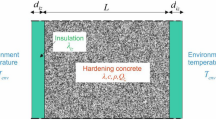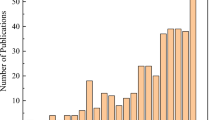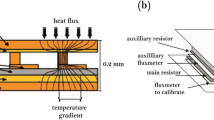Abstract
This paper includes computational analysis of the behavior of concrete subjected to cryogenic temperatures. The analysis is performed by developing a computationally implemented meso-scale model of concrete as a 3-phase composite that consists of mortar matrix, aggregate, and interfacial transition zone. The modeling results provide insight on the effects of concrete mixture design and properties on resistance to damage during cooling to cryogenic temperatures. The results show that the most important factor that affects damage is the difference in the coefficient of thermal expansion between the mortar and aggregates. Models in which the mortar and aggregate had close values of positive coefficients are predicted to experience less damage. The modeled material with irregular shape particles is predicted to experience more localized damage than the modeled material with circular shape particles. In addition, the model predicts a reduction in damage when air entrainment is present. The damage results predicted by the model for air entrained and non-air entrained concrete are in general agreement with experimental data from the literature.

















Similar content being viewed by others
References
Krstulovic-Opara N (2007) Liquefied, natural gas storage: material behavior of concrete at cryogenic temperatures. ACI Mater J 104(3):297–306
Miura T (1989) The properties of concrete at very low temperatures. Mater Struct 22(4):243–254
Kogbara RB, Iyengar SR, Grasley ZC, Masad EA, Zollinger DG (2013) A review of concrete properties at cryogenic temperatures: towards direct long containment. Constr Build Mater 47:760–770
Rostasy FS, Schneider U, Wiedemann G (1979) Behavior of mortar and concrete at extremely low-temperatures. Cem Concr Res 9(3):365–376
Marshall AL (1982) Cryogenic concrete. Cryogenics 22(11):555–565
van Breugel K (1982) A designers perspective on cryogenic storage-systems for liquefied industrial gases. Cryogenics 22(7):331–334
Kim SM (2010) Continuum-based multiscale computational damage modeling of cementitious composites. Civil Engineering. Ph.D. Texas A&M University, College Station
Abu Al-Rub RK, Kim SM (2010) Computational applications of a coupled plasticity-damage constitutive model for simulating plain concrete fracture. Eng Fract Mech 77(10):1577–1603
Abaqus manual theory 6.8.3. (2008) Dassault Systèmes Simulia Corp., Providence, RI, USA
Cicekli U, Voyiadjis GZ, Abu Al-Rub RK (2007) A plasticity and anisotropic damage model for plain concrete. Int J Plast 23(10–11):1874–1900
Kachanov L (1958) On the creep fracture time. Izvestiya Akademii Nauk SSSR. Otdelenie Tekhnicheskikh Nauk 8:26–31
Lemaitre J, Chaboche JL (1978) Phenomenological approach of damage rupture. Journal De Mecanique Appliquee 2(3):317–365
Lubliner J, Oliver J, Oller S, Onate E (1989) A plastic-damage model for concrete. Int J Solids Struct 25(3):299–326
Lee JH, Fenves GL (1998) Plastic-damage model for cyclic loading of concrete structures. J Eng Mech 124(8):892–900
Taqieddin ZN (2008) Elasto-plastic and damage modeling of reinforced concrete. Civil Engineering. Ph.D. Louisiana State University, Louisiana
Inada Y, Kinoshita N, Ebisawa A, Gomi S (1997) Strength and deformation characteristics of rocks after undergoing thermal hysteresis of high and low temperatures. Int J Rock Mech Min Sci 34(3–4):140–141
Lee GC, Shih TS, Chang KC (1988) Mechanical properties of high-strength concrete at low temperature. J Cold Reg Eng 2(4):169–178
Yang CC, Lin YY (1996) Elastic modulus of concrete affected by elastic moduli of mortar and artificial aggregate. J Mar Sci Technol 4(1):43–48
Zheng JJ, Li CQ, Zhou XZ (2005) Thickness of interfacial transition zone and cement content profiles around aggregates. Mag Concr Res 57(7):397–406
Sonebi M (2008) Utilization of micro-indentation technique to determine the micromechanical properties of ITZ in cementitious materials. ACI Spec Publ 254:57–67
Mukhopadhyay AK, Zollinger DG (2009) Development of dilatometer test method to measure coefficient of thermal expansion of aggregates. J Mater Civ Eng 21(12):781–788
Wang ZM, Kwan AKH, Chan HC (1999) Mesoscopic study of concrete I: generation of random aggregate structure and finite element mesh. Comput Struct 70(5):533–544
Du CB, Sun LG (2007) Numerical simulation of aggregate shapes of two-dimensional concrete and its application. J Aerosp Eng 20(3):172–178
Moon JH (2006) Autogenous shrinkage, residual stress, and cracking in cementitious composites: the influence of internal and external restraint. Civil Engineering. Ph.D. Purdue University, West Lafayette
Callan EJ (1952) Thermal expansion of aggregates and concrete durability. ACI J Proc 48(2):485–504
Dela BF, Stang H (2000) Two-dimensional analysis of crack formation around aggregates in high-shrinkage cement paste. Eng Fract Mech 65(2):149–164
Rahman S, Grasley Z (2014) A poromechanical model of freezing concrete to elucidate damage mechanisms associated with substandard aggregates. Cem Concr Res 55:88–101
Verbeck GJ, Landgren R (1960) Influence of physical characteristics of aggregates on frost resistance of concrete. PCA Bull 126(60):1063–1079
ACI 376 code requirements for design and construction of concrete structures for the containment of refrigerated gases and commentary. 2010, American Concrete Institute
Cohen MD, Zhou YX, Dolch WL (1992) Non air-entrained high-strength concrete: is it frost resistant? ACI Mater J 89(4):406–415
Philleo RE (1986) Freezing and thawing resistance of high-strength concrete. Transportation Research Board
Lukefahr E, Du LX (2010) Coefficients of thermal expansion of concrete with different coarse aggregates-texas data. J Test Eval 38(6):683–690
Acknowledgments
The authors thank Dr. Eyad Masad for his technical assistance. This paper was made possible by a NPRP award [4-410-2-156] from the Qatar National Research Fund (a member of The Qatar Foundation). The statements made herein are solely the responsibility of the authors.
Author information
Authors and Affiliations
Corresponding author
Rights and permissions
About this article
Cite this article
Masad, N., Zollinger, D., Kim, SM. et al. Meso-scale model for simulations of concrete subjected to cryogenic temperatures. Mater Struct 49, 2141–2159 (2016). https://doi.org/10.1617/s11527-015-0639-x
Received:
Accepted:
Published:
Issue Date:
DOI: https://doi.org/10.1617/s11527-015-0639-x




